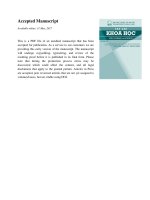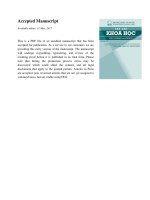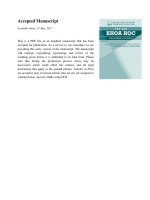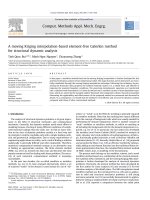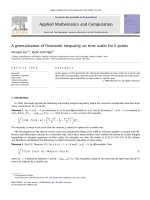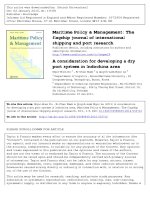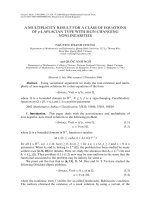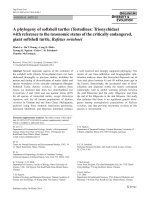DSpace at VNU: A MULTIPLICITY RESULT FOR A CLASS OF EQUATIONS OF p-LAPLACIAN TYPE WITH SIGN-CHANGING NONLINEARITIES
Bạn đang xem bản rút gọn của tài liệu. Xem và tải ngay bản đầy đủ của tài liệu tại đây (110.79 KB, 12 trang )
Glasgow Math. J. 51 (2009) 513–524. C 2009 Glasgow Mathematical Journal Trust.
doi:10.1017/S001708950900514X. Printed in the United Kingdom
A MULTIPLICITY RESULT FOR A CLASS OF EQUATIONS
OF p-LAPLACIAN TYPE WITH SIGN-CHANGING
NONLINEARITIES
NGUYEN THANH CHUNG
Department of Mathematics and Informatics, Quang Binh University, 312 Ly Thuong Kiet,
Dong Hoi, Quang Binh, Vietnam
e-mail:
´ˆ C ANH NGO
ˆ
and QUO
Department of Mathematics, College of Science, Vietnam National University, Hanoi, Vietnam
Department of Mathematics, National University of Singapore, Science Drive 2, Singapore 117543
e-mail: bookworm
(Received 11 July 2008; accepted 22 December 2008)
Abstract. Using variational arguments we study the non-existence and multiplicity of non-negative solutions for a class equations of the form
−div(a(x, ∇u)) = λf (x, u) in
,
where
is a bounded domain in ޒN , N 3, f is a sign-changing Carath´eodory
function on × [0, +∞) and λ is a positive parameter.
2002 Mathematics Subject Classification. 35J20, 35J60, 35J65, 58E05.
1. Introduction. This paper deals with the non-existence and multiplicity of
non-negative, non-trivial solutions to the following problem,
−div(a(x, ∇u)) = λf (x, u) in
u = 0 on ∂ ,
where
,
(1.1)
(1.2)
is a bounded domain in ޒN , function a satisfies
|a(x, ξ )|
c0 (h0 (x) + h1 (x)|ξ |p−1 )
for all ξ ∈ ޒN , a.e. x ∈ , h0 (x) 0, h1 (x) 1 for a.e. x ∈ , p 2 and λ > 0 is a
parameter. When h0 and h1 belong to L∞ ( ), the problem has been studied by many
p
authors (see [2, 8, 10] for details). Here we study the situation that h0 ∈ L p−1 ( ) and
h1 ∈ L1loc ( ). Then problem (1.1)–(1.2) now may be non-uniform in the sense that the
functional associated to the problem may be infinity for some u.
We point out the fact that in [4, 13], D. M. Duc and N. T. Vu have studied the
following Dirichlet elliptic problem,
−div(a(x, ∇u)) = f (x, u) in
u = 0 on ∂ ,
,
(1.3)
(1.4)
where the nonlinear term f verifies the so-called Ambrosetti–Rabinowitz condition.
The authors obtained the existence of a weak solution by using a variant of the
´ˆ C ANH NGO
ˆ
NGUYEN THANH CHUNG AND QUO
514
Mountain pass theorem introduced in [3]. Then, H. Q. Toan and Q.-A. Ngoˆ [12] gave
some multiplicity results in the case when f (x, u) = h(x)|u|r−1 u + g(x)|u|s−1 u. Using
the Mountain pass theorem in [3] combined with Ekeland’s variational principle in [5]
they proved that problem (1.3)–(1.4) has at least two weak solutions.
Motivated by K. Perera [10] and M. Mih˘ailescu and V. R˘adulescu [7], the goal of
this work is to investigate the problem (1.1)–(1.2) with positive parameter λ and the
sign-changing nonlinearity f . We also do not require that the nonlinear term f verifies
the Ambrosetti–Rabinowitz condition as in [4, 12].
In order to state our main result, let us introduce the following hypotheses on
problem (1.1)–(1.2).
Assume that N 3 and 2 p < N. Let
be a bounded domain with a
smooth boundary ∂ . Consider that a : × ޒN → ޒN , a = a(x, ξ ), is the continuous
derivative with respect to ξ of the continuous function A : × ޒN → ޒ, A = A(x, ξ ),
that is, a(x, ξ ) = ∂A(x, ξ )/∂ξ and A(x, 0) = 0 for a.e. x ∈ . Assume that there are
positive constant c0 and two non-negative measurable functions h0 , h1 such that
h0 ∈ Lp/p−1 ( ), h1 ∈ L1loc ( ), h1 (x) 1, a.e. x ∈ . Suppose that a and A satisfy the
following hypotheses.
(A1 ) |a(x, ξ )| c0 (h0 (x) + h1 (x)|ξ |p−1 ) for all ξ ∈ ޒN , a.e. x ∈
(A2 ) The following inequality holds
.
(a(x, ξ ) − a(x, ψ)) · (ξ − ψ)
0
for all ξ, ψ ∈ ޒN , a.e. x ∈ , with equality if and only if ξ = ψ.
(A3 ) There exists a positive constant k0 such that
A x,
ξ +ψ
2
1
1
A(x, ξ ) + A(x, ψ) − k0 h1 (x)|ξ − ψ|p
2
2
for all ξ, ψ ∈ ޒN , a.e. x ∈ , that is, A is p-uniformly convex.
(A4 ) There exists a constant k1 > 0 such that the following inequalities hold true
k1 h1 (x)|ξ |p
for all ξ ∈ ޒN , a.e. x ∈
a(x, ξ ) · ξ
pA(x, ξ )
.
EXAMPLE 1.
1. Let
A(x, ξ ) =
h(x) p
|ξ | ,
p
a(x, ξ ) = h(x)|ξ |p−2 ξ,
with p 2 and h ∈ L1loc ( ). Then we get the operator div(h(x)|∇u|p−2 ∇u), and
if h(x) ≡ 1 in we conclude the well-known p-Laplacian operator
pu
:= div(|∇u|p−2 ∇u)
as in [8, 10].
2. Let
A(x, ξ ) =
p
h(x)
(1 + |ξ |2 ) 2 − 1
p
MULTIPLICITY RESULT FOR A CLASS OF p-LAPLACIAN-TYPE EQUATIONS
with p
515
p
2, h ∈ L p−1 ( ). Then
a(x, ξ ) = h(x)(1 + |ξ |2 )
p−2
2
ξ.
We obtain the generalised mean curvature operator
div h(x)(1 + |∇u|2 )
p−2
2
∇u .
It should be observed that the above examples have not been considered in [2, 8, 10]
yet. For more information and connection on these operators, the reader may consult
either [2] or [8] and the references therein.
As in [10], we assume that function f : × [0, +∞) → ޒis a sign-changing
Carath´eodory function and satisfies the following hypotheses:
(F1 ) f (x, 0) = 0, |f (x, t)| Ctp−1 for all t ∈ [0. + ∞), a.e. x ∈ , and for some
constant C > 0.
(F2 ) There exist two positive constants t0 , t1 > 0 such that F(x, t) 0 for 0 t t0
and F(x, t1 ) > 0.
t
0 uniformly in x, where F(x, t) = 0 f (x, s) ds.
(F3 ) lim sup F(x,t)
tp
t→∞
Let W 1,p ( ) be the usual Sobolev space and W0 ( ) be the closure of C0∞ ( )
under the norm
1,p
|∇u| dx
u =
p
1
p
.
1,p
We now consider the following subspace of W0 ( ):
1,p
H := u ∈ W0 ( ) :
h1 (x)|∇u|p dx < +∞ .
Then H is an infinite dimensional Banach space with respect to the norm (see [4])
u
We define the functional
λ
H
=
1
p
p
h1 (x)|∇u| dx
.
: H → ޒby
λ (u)
=
(u) − I(u),
(1.5)
where
(u) =
A(x, ∇u) dx ,
I(u) = λ
F(x, u) dx ,
u ∈ H.
(1.6)
1,p
Since h0 ∈ Lp/p−1 ( ), then the value λ (u) may be infinity for some u ∈ W0 ( ), that
1,p
is, the functional may not be defined throughout W0 ( ). In order to overcome this
1,p
difficulty, we choose the subspace H of W0 ( ).
516
´ˆ C ANH NGO
ˆ
NGUYEN THANH CHUNG AND QUO
DEFINITION 1. We say that u ∈ H is a weak solution of problem (1.1)–(1.2) if and
only if
a(x, ∇u)∇ϕ dx −λ
f (x, u)ϕ dx = 0
(1.7)
for all ϕ ∈ C0∞ ( ).
Then we have the following remark which plays an important role in our arguments.
REMARK 1.
(i) By (A4 ) and (i) in Proposition 2, it is easy to see that
1,p
1,p
H = u ∈ W0 ( ) : (u) < ∞ = u ∈ W0 ( ) :
(ii) Since h1 (x) 1, a.e. x ∈
continuous embeddings
, we have u
1,p
H → W0 ( ) → Li ( ),
u
p
H
λ (u)
<∞ .
for all u ∈ H. Thus, the
i
p∗
hold true.
h1 (x)|∇u|p dx < +∞ for any u ∈ C0∞ ( ) and h1 ∈ L1loc ( ), we have
(iii) Since
∞
C0 ( ) ⊂ H.
The main result for the existence of solutions of (1.1) can be formulated as follows.
THEOREM 1. Under hypotheses (A1 )–(A4 ) and (F1 ), there exists a positive constant
λ such that for all λ ∈ (0, λ), problem (1.1)–(1.2) has no weak solution.
THEOREM 2. Under hypotheses (A1 )–(A4 ) and (F1 )–(F3 ), there exists a positive
constant λ such that for all λ λ, problem (1.1)–(1.2) has at least two distinct nonnegative, non-trivial weak solutions.
To prove Theorem 2, we first prove that the functional associated to the problem
(1.1)–(1.2) is bounded from below and coercive, and thus the first weak solution is
obtained due to a variant of the minimum principle which we will prove in the next
section (see Theorem 4). To obtain the second solution to the problem (1.1)–(1.2), we
shall use a variant of the mountain pass theorem due to Duc (see Proposition 1).
may not be
2. Auxiliary results. Due to the presence of h1 , functional
continuously Fr´echet differentiable functionals on H. This means that we cannot apply
the classical Mountain pass theorem by Ambrosetti–Rabinowitz (see [1] for details).
To overcome this difficulty, we shall use a weak version of the Mountain pass theorem
introduced by Duc [3]. Now we introduce the following concept of weakly continuously
differentiability due to Duc.
DEFINITION 2. Let F be a map from a Banach space X to ޒ. We say that F is
weakly continuously differentiable on X if and only if the following two conditions are
satisfied:
(i) For any u ∈ X there exists a linear map DF(u) from X to ޒsuch that
F (u + tv) − F(u)
= DF(u) (v)
t→0
t
lim
for every v ∈ X.
MULTIPLICITY RESULT FOR A CLASS OF p-LAPLACIAN-TYPE EQUATIONS
517
(ii) For any v ∈ X, the map u → DF(u) (v) is continuous on X.
REMARK 2. If we suppose further that v → DF(u) (v) is continuous linear mapping
on X, then F is Gˆateaux differentiable.
DEFINITION 3. We call u a generalised critical point (critical point, for short) of F
if DF(u) = 0. c is called a generalised critical value (critical value, for short) of F if
F(u) = c for some critical point u of F.
Denote by Cw1 (X) the set of weakly continuously differentiable functionals on X.
It is clear that C 1 (X) ⊂ Cw1 (X) where we denote by C 1 (X) the set of all continuously
Fr´echet differentiable functionals on X. Now let F ∈ Cw1 (X); we put
DF(u) = sup{|DF(u)(h)|h ∈ Y, h = 1}
for any u ∈ X, where DF(u) may be +∞.
DEFINITION 4. We say that F satisfies the Palais-Smale condition at level c ∈ ޒ
(denoted by (PS)c ) if any sequence {un } ⊂ X for which
F(un ) → c
and
DF(un ) → 0 in X
possesses a convergent subsequence. If this is true at every level c then we simply say
that F satisfies the Palais-Smale condition (denoted by (PS)).
DEFINITION 5. We say that F satisfies the Cerami condition at level c ∈ ( ޒdenoted
by (C)c ) if any sequence {un } ⊂ X for which
F(un ) → c
and
(1 + xn )DF (un ) → 0 in X
possesses a convergent subsequence. If this is true at every level c, then we simply say
that F satisfies the Cerami condition (denoted by (C)).
In the proof of our main theorems, we shall use the following results which is
proved in [9]. We will recall its proof for completeness.
THEOREM 3 (see [9]). Let F ∈ Cw1 (X) where X is a Banach space. Assume that
(i) F is bounded from below, c = inf F,
(ii) F satisfies the (PS) condition.
Then c is a critical value of F (i.e. there exists a critical point u0 ∈ X such that F(u0 ) = c)
Proof of Theorem 3. Let c be an arbitrary real number. Before proving the theorem,
we need the following notation:
F c = {u ∈ X|F(u)
c}.
Let us assume, by negation, that c is not a critical value of F. Then, Theorem 2.2 in [13]
implies the existence of ε > 0 and η ∈ C([0, +∞) × X, X) satisfying η(1, F c+ε ) ⊂ F c−ε .
This is a contradiction since F c−ε = ∅ due to the fact that c = inf F.
REMARK 3. By Corollary 2.1.1 in [6], if F : X → ޒis a locally Lipschitz, bounded
from below function and it satisfies the (C) condition, then F is coercive. This leads us
to state the following lemma.
´ˆ C ANH NGO
ˆ
NGUYEN THANH CHUNG AND QUO
518
LEMMA 1. If F : X → ޒis a locally Lipschitz, bounded from below function and it
satisfies the (C) condition then it satisfies the (PS) condition.
Proof. Let {un }n ⊂ X be a sequence such that F(un ) is bounded and DF(un ) → 0
in X . By Remark 3, F is coercive, and this helps us to deduce that {un }n is bounded in
X. Hence also (1 + un )DF(un ) → 0 in X , and because F satisfies the (C) condition,
it follows that {un }n has a strongly convergent subsequence. This completes the
proof.
Similar to Theorem 3, we have the following new result.
THEOREM 4. Let F be continuous on X and be of class Cw1 (X) where X is a Banach
space. Assume that
(i) F is bounded from below, c = inf F,
(ii) F satisfies the (C) condition.
Then c is a critical value of F (i.e. there exists a critical point u0 ∈ X such that F(u0 ) = c).
The proof of Theorem 4 follows from Lemma 1, so we omit it. Next we provide a
variant Mountain pass theorem due to Duc [3].
PROPOSITION 1 (see [3]). Let F ∈ Cw1 (X) where X is a Banach space and satisfies
(PS) condition. Assume that F(0) = 0 and there exist a positive constant ρ and z0 ∈ X
such that
(i) z0 X > ρ and F(z0 ) 0.
(ii) α = inf {F(u) : u ∈ X, u X = ρ} > 0.
Assume that the set
G = {ϕ ∈ C([0, 1], X) : ϕ(0) = 0, ϕ(1) = z0 }
is not empty. Put
β := inf {max F(ϕ([0, 1])) : ϕ ∈ G} .
Then β
α and β is a critical value of F.
For the use of Proposition 1, we refer the reader to [3, 12, 13]. We end
this section by studying some certain properties of the functional λ given
by (1.5) but we first recall some results which will be used throughout this
work.
PROPOSITION 2 (see [4]).
(i) A verifies the growth condition
|A(x, ξ )|
c0 (h0 (x)|ξ | + h1 (x)|ξ |p )
for all ξ ∈ ޒN , a.e. x ∈ .
(ii) A(x, ξ ) is convex with respect to ξ . Moreover, by (A3 ) for all u, v ∈ H we have
u+v
2
1
1
(u) +
(v) − k0 u − v
2
2
p
H
.
(2.1)
Using the method as in [4] with some simple computations we obtain the following
proposition which concerns the smoothness of the functional λ .
MULTIPLICITY RESULT FOR A CLASS OF p-LAPLACIAN-TYPE EQUATIONS
519
PROPOSITION 3.
1,p
(i) If {um } is a sequence weakly converging to u in W0 ( ), then
(u)
lim inf
(um )
m→∞
and
lim I(um ) = I(u).
m→∞
(ii) The functionals and I are continuous on H.
(iii) Functional λ is weakly continuously differentiable on H and we have
D
λ (u)(ϕ)
=
a(x, ∇u)∇ϕ dx −λ
f (x, u)ϕ dx
for all u, ϕ ∈ H.
3. Proofs of the theorems.
Proof of Theorem 1. Let us denote by S the best constant in the Sobolev embedding
) → Lp ( ), i.e.
1,p
W0 (
1
p
|∇u|p dx
S=
inf
1,p
W0 ( )\{0}
|u| dx
p
1
p
.
(3.1)
Then, if u is a weak solution of problem (1.1)–(1.2), multiplying (1.1) by u and
integrating by parts combined with conditions (A4 ) and (F1 ) gives
k1
|∇u|p dx
k1
h1 (x)|∇u|p dx
(3.2)
a(x, ∇u)∇u dx = λ
f (x, u)u dx
Cλ
|u|p dx .
Hence, choosing λ = k1 S/C, where S is given by (3.1), we conclude the proof.
We will prove Theorem 2 by using critical point theory. Set f (x, t) = 0 for all t < 0
and consider the energy functional λ : H → ޒwhich is given by (1.5).
LEMMA 2. If u is a critical point of
λ
then u is non-negative in
Proof. Observe that if u is a critical point of
of u, i.e. u− (x) = min {u(x), 0} we have
0=D
−
λ (u)(u )
λ,
denoting by u− the negative part
a(x, ∇u)∇u− dx −λ
=
.
f (x, u)u− dx
(3.3)
k1
h1 (x)|∇u− |p dx = k1 u−
p
H,
which yields that u 0 for a.e. x in . Thus, non-trivial critical points of the functional
λ are non-negative, non-trivial solutions of problem (1.1)–(1.2).
´ˆ C ANH NGO
ˆ
NGUYEN THANH CHUNG AND QUO
520
The following lemma shows that the functional λ satisfies all of the assumptions
of Theorem 3. Then problem (1.1)–(1.2) admits a weak solution u1 ∈ H as a global
minimiser and u1 0.
LEMMA 3. The functional
on H.
λ
is bounded from below and satisfies the (PS) condition
Proof. By conditions (F1 ) and (F3 ), there exists a constant Cλ = C(λ) > 0 such
that
λF(x, t)
for all t ∈ ޒand a.e. x ∈
λ (u)
k1 S p
|t| + Cλ
2p
(3.4)
. Hence,
=
A(x, ∇u) dx −λ
F(x, u) dx
k1
h1 (x)|∇u|p dx −
p
k1
p
u H − Cλ | |,
2p
k1 S p
|u| + Cλ dx
2p
(3.5)
where | | denotes the Lebesgue measure of
in ޒN . Thus, the functional
coercive and hence bounded from below on H.
Let {um } be a Palais-Smale sequence in H, i.e.
|
λ (um )|
c for all m,
λ (um )
→ 0 in H .
λ
is
(3.6)
Since λ is coercive on H, {um } is bounded in H. By Remark 1 (ii), {um } is bounded in
1,p
1,p
W0 ( ). It follows that there exists u ∈ W0 ( ) such that, passing to a subsequence,
1,p
still denoted by {um }, it converges weakly to u in W0 ( ). We shall prove that {um }
converges strongly to u in H.
Indeed, we observe by Remark 1(i), Proposition 3(i) and (3.6) that u ∈ H. Hence,
{ um − u H } is bounded. This and (3.6) imply that D λ (um )(um − u) converges to 0 as
m → ∞.
¨
inequality we deduce that
Using condition (F1 ) combined with Holder’s
0
|f (x, um )||um − u| dx
C
C
|um |p−1 |um − u| dx
p−1
um Lp ( )
um − u
Lp ( )
(3.7)
.
1,p
Since the embedding W0 ( ) → Lp ( ) is compact, {um } converges strongly to u in
Lp ( ). Therefore, relation (3.7) implies that
lim DI(um )(um − u) = 0.
m→∞
Combining relations (3.6) and (3.8) with the fact that
D (um )(um − u) = D
λ (um )(um
− u) + DI(um )(um − u),
(3.8)
MULTIPLICITY RESULT FOR A CLASS OF p-LAPLACIAN-TYPE EQUATIONS
521
we conclude that
lim D (um )(um − u) = 0.
(3.9)
m→∞
On the other hand, the convex property of functional
that
(u) − lim
m→∞
(um ) = lim ( (u) −
m→∞
(um ))
(see Proposition 2(ii)) implies
lim D (um )(u − um ) = 0.
m→∞
(3.10)
Combining this with Proposition 3(i), we have
(um ) =
lim
m→∞
(u).
(3.11)
We now assume by contradiction that {um } does not converge strongly to u in H,
and then there exist a constant > 0 and a subsequence {umk } of {um } such that
. Using Proposition 2(ii) we get
umk − u H
umk + u
2
1
1
(u) +
(umk ) −
2
2
k0 umk − u
p
H
k0 p .
(3.12)
Letting k → ∞, relation (3.12) gives
lim sup
k→∞
umk +u
}
2
We remark that sequence {
Proposition 3(i) again we get
(u)
umk + u
2
(u) − k0 p .
(3.13)
1,p
also converges weakly to u in W0 ( ). So, using
lim inf
k→∞
umk + u
,
2
(3.14)
which contradicts (3.13). Therefore, {um } converges strongly to u in H.
LEMMA 4. There exists a positive constant λ such that for all λ
and hence u1 ≡ 0, i.e. the solution u1 is not trivial.
λ, inf H
λ
< 0,
Proof. Let 0 ⊂ be a compact subset large enough and a function ϕ0 ∈ C0∞ ( )
such that ϕ0 (x) = t1 in 0 and 0 ϕ0 (x) t1 in \ 0 , where t1 is chosen as in
assumption (F2 ): then we have
p
F(x, ϕ0 ) dx
F(x, ϕ0 ) dx −Ct1 | \
0|
> 0.
(3.15)
0
Thus, λ (ϕ0 ) < 0 for λ λ with λ large enough. This implies that inf H
then λ (u1 ) < 0 for λ λ, i.e. u1 ≡ 0.
λ
< 0 and
In the next part of this paper, we shall show the existence of the second solution
u2 = u1 by using the Mountain pass theorem introduced in [3]. To this purpose, we
´ˆ C ANH NGO
ˆ
NGUYEN THANH CHUNG AND QUO
522
first fix λ
λ and set
⎧
⎪
⎨0,
f (x, t) = f (x, t)
⎪
⎩
f (x, u1 (x))
and F(x, t) =
t
0
for t < 0,
for 0 t u1 (x),
for t > u1 (x),
f (x, s) ds. Define the functional
λ (u)
=
λ
A(x, ∇u) dx −λ
: H → ޒby
F(x, u) dx .
With the same arguments as those used for the functional
weakly continuously differentiable on H and
D
λ (u)(ϕ)
=
(3.16)
a(x, ∇u)∇ϕ dx −λ
λ,
(3.17)
we can show that
λ
is
f (x, u)ϕ dx
for all u, ϕ ∈ H.
LEMMA 5. If u ∈ H is a critical point of
(1.1)–(1.2) in the order interval [0, u1 ].
Proof. By the definitions of λ and
before and by condition (A2 ) we have
0 = (D
=
λ (u)
λ,
λ (u1 ))((u
then u
u1 . So, u is a solution of problem
if u is a critical point of
λ
then u
0 as
− u1 )+ )
(a(x, ∇u) − a(x, ∇u1 )) · ∇(u − u1 )+ dx
−λ
=
−D
λ
{u>u1 }
(3.18)
(f (x, u) − f (x, u1 ))(u − u1 )+ dx
(a(x, ∇u) − a(x, ∇u1 )) · (∇u − ∇u1 ) dx
0.
According to (3.18) and condition (A2 ), the equality holds if and only if ∇u = ∇u1 . It
follows that ∇u(x) = ∇u1 (x) for all x ∈ 1 := {y ∈ : u(y) > u1 (y)}. Hence,
|∇(u − u1 )+ |p dx = 0.
|∇(u − u1 )|p dx = 0 and thus
1
Combining this with Remark 1(ii), we conclude that (u − u1 )+
(u − u1 )+ = 0 in , that is, u u1 in .
LEMMA 6. There exist a constant ρ ∈ (0, u1
α for all u ∈ H with u H = ρ.
H)
Lp ( )
= 0 and then
and a constant α > 0 such that
λ (u)
Proof. We set u = {x ∈ : u(x) > min {u1 (x), t0 }}, where t0 is given as in (F2 ).
Then, by (3.16) and condition (F1 ), we have F(x, u(x)) 0 on \ u . Hence,
λ (u)
k1 u
p
H
−λ
F(x, u) dx .
u
(3.19)
MULTIPLICITY RESULT FOR A CLASS OF p-LAPLACIAN-TYPE EQUATIONS
523
¨
Using (F1 ), Holder’s
inequality and Remark 1(ii), we get
F(x, u) dx
|u|p dx
C
u
where q =
Np
.
N−p
C|
u|
u|
1− pq
1− pq
u
p
H,
(3.20)
u
Therefore,
λ (u)
u
p
H
k1 − λC|
.
(3.21)
In order to prove Lemma 6, it is enough to show that | u | → 0 as u H → 0. Indeed,
⊂ a compact subset, large enough such that
let > 0 be arbitrary; we choose
| \ | < , and denote by u, := u ∩ . Then it is clear that
u
p
H
u
|u|p dx
p
up dx
lp|
u,
|,
(3.22)
u,
where l = min {min u1 ( ), t0 }. Letting u H → 0 we deduce that | u, | → 0. Since
we have | u | | u, | + with > 0 as arbitrary. Thus, | u | → 0
u ⊂
u, ∪ \
as u H → 0.
LEMMA 7. Functional
λ
satisfies the (PS) condition on H.
Proof. We observe by (3.21) that λ is coercive. Therefore, every Palais-Smale
sequence of λ is bounded in H. We follow the method as those used in the proof of
Lemma 3. It can be shown that the functional λ satisfies the (PS) condition on H.
Proof of Theorem 2. By Lemmas 2–4, using Theorem 3, problem (1.1)–(1.2) admits
a non-negative, non-trivial weak solution u1 . Setting
c := inf max
γ ∈ u∈γ ([0,1])
λ (u),
(3.23)
where := {γ ∈ C([0, 1], H) : γ (0) = 0, γ (1) = u1 }, Lemmas 6–7 show that all of the
assumptions of Proposition 1 are fulfilled, λ (u1 ) = λ (u1 ) < 0 and u1 H > ρ. Then,
c > 0 is a critical value of λ , i.e. there exists u2 ∈ H such that D λ (u2 )(ϕ) = 0 for
all ϕ ∈ H and λ (u2 ) = c > 0. By Lemma 5, 0 u2 u1 in . Therefore, using (3.16)
some simple computations give us
λ (u2 )
=
λ (u2 ),
D
λ (u2 )(ϕ)
=D
λ (u2 )(ϕ)
for all ϕ ∈ H.
By Remark 1(iii), we conclude that u2 is a weak solution of problem (1.1)–(1.2).
Furthermore, λ (u2 ) = c > 0 > λ (u1 ). Thus, u2 is not trivial and u2 = u1 . The proof
of Theorem 2 is now complete.
REFERENCES
1. A. Ambrosetti and P. H. Rabinowitz, Dual variational methods in critical points theory
and applications, J. Funct. Anal. 4 (1973), 349–381.
2. P. De N´apoli and M. C. Mariani, Mountain pass solutions to equations of p-Laplacian
type, Nonlinear Anal. 54 (2003), 1205–1219.
3. D. M. Duc, Nonlinear singular elliptic equations, J. Lond. Math. Soc. 40(2) (1989),
420–440.
524
´ˆ C ANH NGO
ˆ
NGUYEN THANH CHUNG AND QUO
4. D. M. Duc and N. T. Vu, Non-uniformly elliptic equations of p-Laplacian type,
Nonlinear Anal. 61 (2005), 1483–1495.
5. I. Ekeland, On the variational principle, J. Math. Anal. Appl. 47 (1974), 324–353.
´
6. L. Gasinski
and N. S. Papageorgiou, Nonsmooth critical point theory and nonlinear
boundary value problems. Series in Mathematical Analysis and Applications, 8. Chapman &
Hall/CRC, Boca Raton, FL, 2005.
7. M. Mih˘ailescu and V. R˘adulescu, A multiplicity result for a nonlinear degenerate
problem arising in the theory of electrorheological fluids, Proc. R. Soc. Lond. Ser. A 462 (2006),
2625–2641.
8. M. Mih˘ailescu, Existence and multiplicity of weak solutions for a class of denegerate
nonlinear elliptic equations, Boundary Value Probl. (2006), Art. ID 41295, 17 pp.
ˆ and H. Q. Toan, Existence of solutions for a resonant problem under
9. Q.-A. Ngo,
Landesman–Lazer conditions, Electron. J. Diff. Eqns. 2008 (98) (2008), 1–10.
10. K. Perera, Multiple positive solutions for a class of quasilinear elliptic boundary-value
problems, Electron. J. Differential Equations 7 (2003), 1–5.
11. M. Struwe, Variational Methods: Applications to nonlinear partial differential equations
and Hamiltonian systems, 4 ed. (Springer-Verlag, Berlin, 2008).
ˆ Multiplicity of weak solutions for a class of non-uniformly
12. H. Q. Toan and Q.-A. Ngo,
elliptic equations of p-Laplacian type, Nonlinear Anal. 70 (2009), 1536–1546.
13. N. T. Vu, Mountain pass theorem and non-uniformly elliptic equations, Vietnam J.
Math 33 (4) (2005), 391–408.
